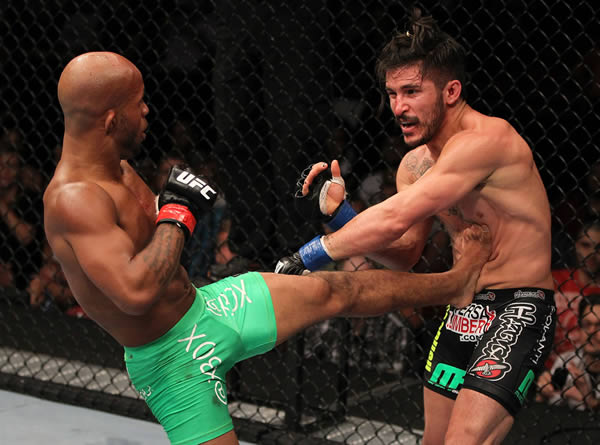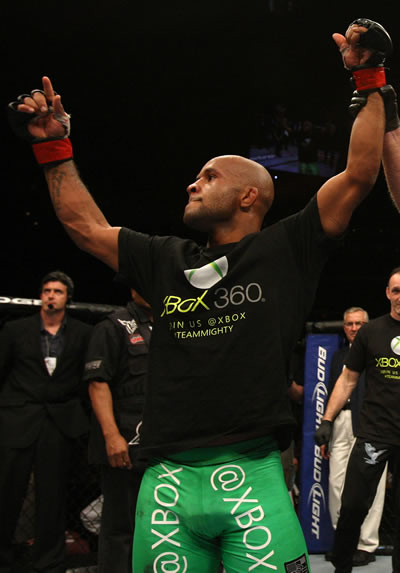
This is a case study on preparatory success, using Demetrious “Mighty Mouse” Johnson’s victory against Ian McCall as a blueprint. In case you missed it, on June 8th, 2012 the UFC got one step closer to having its first Flyweight Champion as DJ soundly defeated Ian McCall with a unanimous decision victory in their rematch. As I’ve discussed elsewhere, DJ is an AMC Pankration fighter that’s been with the camp since the very beginning and I was in his corner for the fight.
Rather than give specific details about his training program, I instead want to focus on the overall blueprint that was followed that led to his victory and has him in the tournament finals, just one win away from a UFC World Championship. This same blueprint is much more universal than any one training program, the principles apply to any sport and really, to any goal. Whether you want to improve your fitness for a particular sport, lose bodyfat and get in better shape or anything in between, the following 5 tips will help you get there faster.
1. Analyze Your Mistakes
After the first against McCall, it was clear that DJ’s performance in the third round wasn’t what it should have been. He was taken down, controlled on the ground and generally looked sluggish and fatigued. This was the first time he had ever really looked this way in the last round of a fight, so the question that had to first be answered was why this happened.
Once all areas of the fight and the preparation for it had been looked at, the biggest change in this fight from previous one was his diet and the weight cut to 125lbs. It was his DJ’s first fight at 125lbs and looking back, it was clear that mistakes were made during fight week and especially after the weight was made. These mistakes led to inadequate rehydration and low glycogen levels that essentially left him fighting in a ketogenic state, certainly not where you want to be for such a high energy, fast paced sport like MMA.
Once the problems in diet had been identified as the biggest factor in his sluggish performance in the third round, the next step was to fix the problems by making the necessary changes in his diet. In the first weight cut, DJ cut carbs too low and didn’t adequately restore glycogen levels after the weight cut, leaving him flat and dehydrated the next day. Going into the rematch, obviously this would be corrected, so we discussed a better approach and how to make sure this wouldn’t happen again.
The result was that he was actually 8lbs heavier during the second fight, mostly water and glycogen, and his conditioning was far better. He controlled the third round and looked to be the fresher of the two. Rather than being taken down, he was the one that got the takedowns and this time, he was the clear winner. The key to all this started with looking at mistakes that were made in the last fight and then being willing to make a change so that they didn’t happen again.

2. Correct Your Weaknesses
Aside from the dietary issues that left him flat and more fatigued than he should have been, it was also clear that in the first fight he was taken down too often. In the second fight, it was pretty obvious that McCall would continue to go for the takedowns since that what worked for him in the first fight, so DJ would have to work on his takedown defense.
This is where having a world-class coach like Matt Hume is invaluable because Matt was able to work with DJ to fix the technical mistakes he was making that were leading to him getting taken down. This was a huge emphasis of the training camp and if you watched the second fight, you could clearly see that McCall wasn’t really ever able to take DJ down and keep him there for more than a second or two. DJ was the one getting the takedowns and controlling the wrestling game, a totally different story than what happened in the first fight and DJ was able to turn a weakness in the first fight into one of his strengths in the second.
Far too often athletes want to continue to do what they’re good at while ignoring their weaknesses. The result is that they never progress and they have the same holes in their game throughout their careers. If you want to avoid this and become a better athlete, you absolutely have to spend time training and working on the areas that are limiting you and keeping you from getting to where you want to be.
3. Have the Right Game Plan
Regardless of the sport, having the right game plan is almost always a key requirement to being successful in it. Fortunately for DJ, Matt is one of the very best there is at coming up with the right game plan and he put together the game plan that DJ needed to follow to beat McCall in the rematch.
He worked with DJ and put together a strategy to make sure he could avoid getting stuck against the cage, to use his footwork and angles to win the striking battle and of course to use his wrestling to keep from getting taken down and controlled as he had in the first fight.
It was clear that going into the second fight, DJ had put together a game plan based on what he knew McCall was going to try to do in the second fight, while McCall had made next to no changes in his game plan at all. He tried to do exactly what he did in the first fight and when DJ had an answer for it this time, he didn’t have anything else. He couldn’t effectively take DJ down and do anything with it, he wasn’t able to win the striking battle and this time, DJ didn’t slow down or fatigue.
According to Sherdog.com, DJ landed far more significant strikes than McCall in each round “22 to 13 in round one, 32 to 20 in round two and 36 to 24 in round three.” Never underestimate the importance of having the right game plan.
4. Manage Your Training
If you’ve read any of my latest work or listened to any of my recent interviews, you know just how important I believe managing a training program is. If you’re not managing your training on a daily, weekly and monthly basis, then you are absolutely not getting the most out of it, period.
With DJ’s training camp, we used BioForce HRV to gauge daily readiness and the weekly and monthly load that his training was imposing on him. During training, we used the Polar T2 system to measure the training load of the different sessions so we knew how to manipulate it based on how well he was recovering and adapting to this program. Of course performance measures were also tracked as well, how much weight he was able to do, how quickly his heart rate was recovering between sets and between rounds, etc.
Aside from these objective measures, we also watched him train, asked how he was feeling and paid attention to the details. This is what coaching is all about and these types of subjective gauges complement what’s found by looking at the hard data. The best coaches will always rely on both and use their intuition and coaching experience along with what the data and the trends in the data are showing.
As a result of this monitoring and management, DJ’s overall fitness levels were as high as they’ve ever been and he performed far better at 125lbs than last time. His resting HR was down in the low 50s and his HRV was in the upper 80s, right where we wanted him to be. Using tools like BioForce HRV and Polar’s T2 system were a huge part of managing the entire training process to make sure that he was well prepared for his fight and that we were pushing him as hard as he should be training, not just as hard as he could be training.

5. Execute & Adjust
Finally, the last major factor that helped DJ get the big win was executing the game plan as he was supposed to and then adjusting as necessary. Even though Matt put together the right game plan and DJ went out and did the things he was trained to do, there were still in-fight adjustments that needed to be made. Matt saw opportunities based on what McCall was and wasn’t doing and he saw mistakes that DJ was making that he needed to stop making.
If you watched the fight you could hear some of what Matt was telling DJ between rounds, but throughout the fight Matt was giving instructions to DJ as well. Regardless of how perfect the game plan may be, there are almost always adjustments that can be made once you put it into effect.
This is exactly the same as with training itself. Even though you might come up with what you think is the perfect program, you never really know how someone is going to respond to it until they actually start doing it. From there, adjustments are made as necessary to make sure the program is having the desired effect and fitness is improving the way that it needs to be.
Whether it’s the competition itself of the training, executing the plan and then adjusting as necessary is one of the real keys to getting the most out of it. Most often the adjustments are small, but you shouldn’t be afraid to make whatever changes necessary.
If HRV and other indicators show an athlete is not recovering well even though it may seem like the load isn’t that high, don’t be afraid to reduce the load and/or increase the rest. A training program should be thought of more as a guideline rather than anything set in stone.
Where He’s At Now
After Demetrious Johnson’s win against Ian McCall, he defeated Joseph Benavidez in the title fight for the newly created UFC Flyweight World Championship. As you can imagine, we used this same blueprint when getting ready for that fight as well. There’s no doubt that Benavidez was a particularly tough opponent; he wouldn’t have been fighting for the title if he wasn’t, but everyone on DJ’s team did everything possible to make sure he was well prepared when he stepped in the Octagon. Since then he has successfully defended his title 6 times, most recently against John Dodson in UFC 191.

I heard Matt Hume on Gross Point Blank, blame Johnson’s performance on the Paleo Diet. Ignorant. The diet is based on food choices and not low carbs. For the low carb want to be athlete, Dr. Volek has a low carb for athletes book covering the science behind ketogenic diets and how they can increase an athlete’s gas tank after a 4-6 week adaptation period.